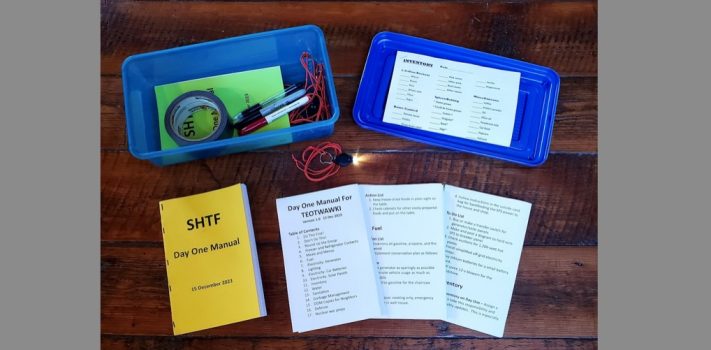by St. Funogas, Survival Blog:

(Continued from Part 1.)
Now, let’s dive in.
MY DAY ONE TEOTWAWKI MANUAL
Table of Contents
1. Do This First!
2. Don’t Do This!
3. Round Up the Group
4. Freezer and Refrigerator Contents
5. Meals and Menus
6. Fuel
7. Electricity: Generator
8. Lighting
9. Electricity: Using Car Batteries
10. Electricity: Whole-house Solar Panels
11. Inventory
12. Water
13. Sanitation
14. Garbage Management
15. DOM Copies for Neighbors
16. Defense
17. Nuclear war preps
Points 1-4 are ultra critical for any prepper’s manual and must have the highest priority in order to prevent wasting important and/or irreplaceable resources as well as to get the gang rounded up who will be part of our post-SHTF household.
TRUTH LIVES on at https://sgtreport.tv/
For quick access, my manual resides on top of a certain cabinet in a small tote along with 10 copies of my DOM, a roll of duct tape, necklace flashlights, inventory sheets, etc. (See photo, above.)
Like all preps, testing our manual as a household group will improve our success if we ever have to put it to use in a real situation. These types of drills will pay big dividends. DOM steps can also be tweaked based on what is learned from each drill. We’ve all seen movies where the submarine crew is carrying out a live drill, everybody at their stations carrying out their assigned and well-practiced duties. The captain throws in some curve balls like flooding in the torpedo room to be sure the crew is prepared for any possible situation. We need to do the same with each section of our manual where possible.
THE SECTIONS OF MY DOM
1. Do This First!
These first actions are absolutes, no discussion needed, just action. The reasons for these actions have been read and discussed by the group. To do these takes less than ten minutes. If these haven’t been practiced ahead of time, the group leader should take command of the situation and start giving rapid-fire orders to individuals: “Barney, go shut off the main water valve. Betty, don’t open the fridge and freezer, just duct tape the doors shut. Wilma, shut off the propane-tank valve. I’ll get the DOM box.”
My DOM Action List
Grab the SHTF box from its assigned spot.
Tape the refrigerator and freezer doors shut.
Turn off the main water valve in the well house, tap the water tank to see how full it is.
Turn indoor water valves to 50% for conservation until new routines are understood and put into practice.
Turn off the valve at the propane tank.
When everyone is back in the house, hand out the necklace flashlights and these manuals.
Take 10-15 minutes to review the Manual as group, or as a partial group based on Section 3 below.
Tape the refrigerator and freezer doors shut. Don’t open them for any reason at this time, especially to fetch some food. Speaking from experience, your first “Oh crap!” moment will be when you open the refrigerator and feel all that cold air streaming onto your feet. Taping the doors shut will prevent this from happening until very the moment when your food-preservation measures are being implemented. The cold temperatures must be preserved as long as possible.
Turn off the main water valve. This will prevent using water without the least thought like we do now until the water-conservation plan can be implemented. In my own situation with my own well, there’s a remote chance the generator will be out of commission and the water tank low so the valve gets shut off until all the components can be checked.
Turn inside water valves to 50% so when the main water valve is turned back on the decreased flow will act as a physical reminder that we’re on water-conservation status now.
Turn off the valve at the propane tank. As with water, we habitually turn on stoves and heaters without worrying about conservation. Turn the valve off until the DOM plan is discussed and new propane management strategies are implemented.
Hand out DOMs and necklace flashlights. Once the group is reassembled after completing the above steps, hand out the DOMs and flashlights from the SHTF box. These flashlights are discussed in more detail in the section on lighting.
Take fifteen minutes to review the first sections (in my case 1-7) of the DOM as group. Sit down and have a quick group discussion with the members of the household and review the Do This First section. Too many things will be forgotten and done out of order of priority. Don’t do anything without consulting the manual first. Daily habits are difficult to break. Again, practice drills will reduce the time needed to discuss the DOM principles.
Tasks can be assigned to groups or individuals:
1. Fred – take command
2. Group 1 – responsible for taking care of the first prioritized items in the Manual.
3. Group 2 – responsible for locating and rounding up any household members who may require it (such as kids at school, etc).
Everyone needs to be on the same page (literally!) from the very outset. Don’t think the world will be going to hell so rapidly that the group can’t take 15 minutes to review the first sections of the manual. It will simply be a quick refresher for those who did occasional practice drills. In those cases, it shouldn’t take much more time than that locker-room speech before the team storms the field. If mushroom clouds are visible, this paragraph may not apply.





